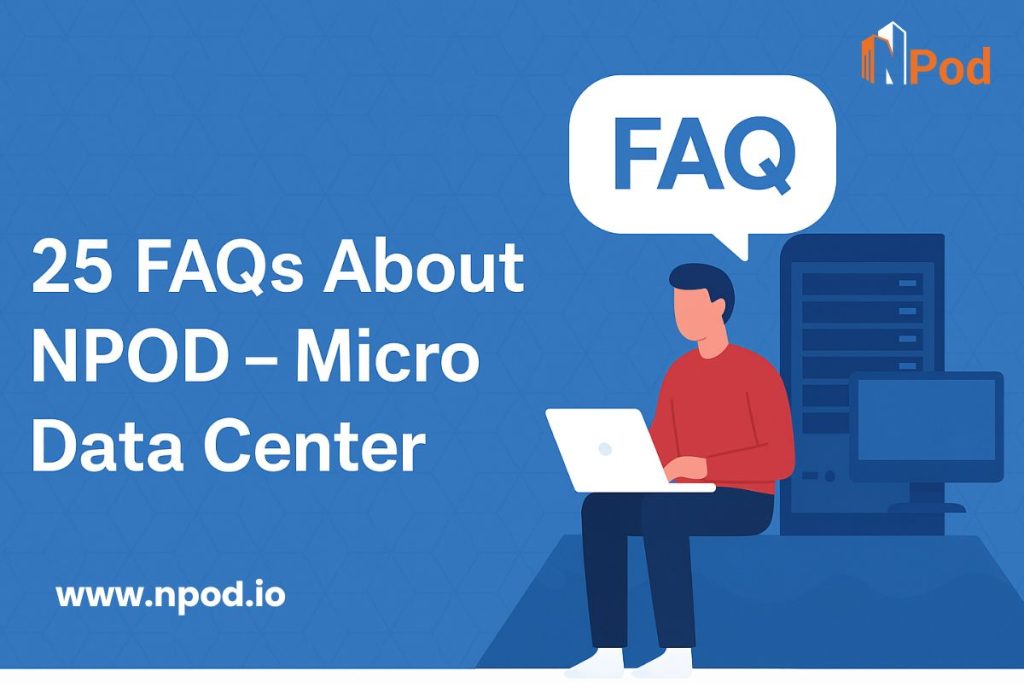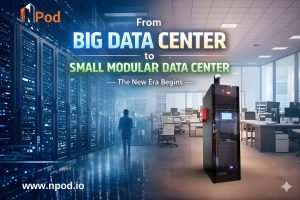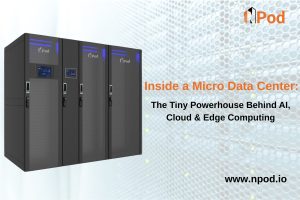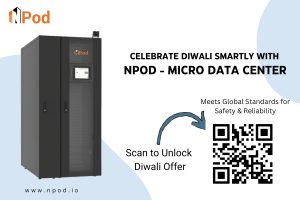-
What is Npod micro data center?
The Npod micro data center is a specialized, fully contained “micro” data center for on-premise storage of servers, network equipment and storage. The Npod micro data center is prefabricated and alternative equipped with a built-in UPS, precision cooling, fire protection and monitoring for a simplified IT infrastructure experience for the modern enterprise and edge locations.
-
What is the difference between a micro data center and a traditional data center?
Unlike large, traditional data centers, which require concrete construction, investment at higher levels and large spaces to house, micro data centers, like the Npod micro data center are smaller, modular, pre-configured, cause faster deployment while saving energy and providing localized compute power.
-
What features come with Npod Micro Data Center?
Npod micro data center integrates important data center infrastructure into one pod;
- Fire suppression
- Precision cooling
- UPS power backup
- Environmental and network monitoring
- Modular scalability
These integrals to make Npod a micro data center that is ready to deploy for broad redundancy.
-
Can in-Npod be deployed on-premises?
Npod is designed for on-premise deployment. Npod allows a business to retain local control, increased security and low latency from a remote cloud data center when accessing critical applications.
-
What are the use cases we might see for Npod Micro Data Center?
Npod micro data center could potentially be used in edge computing, branch IT, smart manufacturing, as telecommunications edge nodes and data hubs for smaller enterprise customers. Npod provides close to the source of data an efficient, compact IT infrastructure.
-
How quickly can Npod Micro Data Center be deployed?
Because Npod is a modular pre-fab product, deployment can happen as quickly as days to weeks which is measured against configuration of the installation, job site readiness for installation, and power availability. This is significantly faster than building out a typical server room in a facility.
-
Can Npod support high-density racks?
Yes, Npod absolutely supports a high density server environment. There’s protocols in place for both cooling and power to support modern IT loads at a higher density. Npod can scale and perform to support virtualization, AI workloads, or edge-computing applications.
-
What cooling system does Npod use?
Npod micro data center uses precise air conditioning (PAC) system with proprietary optimization specific to micro data centers. The Precision A/C will provide consistent humidity and temperature control eliminating thermal extremes within range of operation for IT devices.
-
Is Npod energy efficient?
Yes, Npod was designed with energy efficiency in mind, using smart cooling, optimized airflow, modular power distribution, and intelligent management design.
-
Can Npod grow as a business scales?
Yes, scalability is one of the advantages of Npod micro data center. When your compute or storage demand increases, you simply add as many Npod units as needed. That means you can expand infrastructure on a just-in-time basis for any type of computation or mix of workloads, and you do not have to worry about operational down time or major CAPEX when you are ready to grow.
-
What types of monitoring will Npod provide?
Npod provides remote monitoring for critical parameters including power, temperature, humidity, smoke detection, and bandwidth to enable an administrator to manage and troubleshoot proactively.
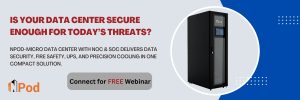
-
Is Npod safe from fire & environmental events?
Yes. Each unit has automatic fire suppression capability, smoke detection, and real-time environmental alerts built in. This allows for continuous operation even in extreme conditions and keeps critical data safe from damage.
-
Does Npod support cloud services?
Yes, Npod micro data center supports hybrid and multi-cloud, and can connect data seamlessly to a public or private cloud. This is very useful in a hybrid IT strategy that leverages on-premise performance with cloud scale.
-
Where is the best place for Npod location?
Npod can be placed anywhere that needs a reliable, onsite compute footprint. Examples include offices, warehouse and factories, telecom towers, educational institutions, or remote edge sites.
-
What happens if there is a power failure on Npod?
Npod has a UPS that will keep the IT loads running even when power has been lost. For extended power failures, an optional generator can be added to further dedicating power to the loads and keeping the business running.
-
What maintenance is required on Npod?
The maintenance is minimal as periodic checks on the UPS batteries, cooling units, and environmental sensors are recommended. It has built-in alerts that help with preventive maintenance.
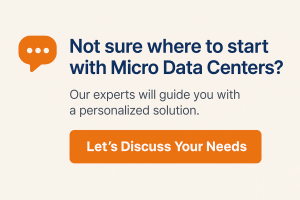
-
Is Npod configurable or customizable?
Yes, Npod is modular and can be customized according to various server rack sizes, power loads, cooling types, and security. This is particularly useful in organizations with unique infrastructure aims.
-
How does Npod relate to edge computing?
Edge computing processes data near where the data was generated. Npod makes this possible by providing local compute and storage, reducing latency to improve data security, and allowing real-time analytics capabilities.
-
Which industries can benefit from Npod micro data centers?
Npod can benefit many industries, including:
- Healthcare: Processing local patient data
- Finance: Secure on-site transactions
- Manufacturing: Automation of smart factory
- Telecom: 5G edge nodes
- Retail: Analytics inside stores and POS processes
-
How reliable is Npod in harsh environments?
Npod is rugged and resilient for demanding environmental challenges. Npod’s controlled enclosure facilitates consistent performance in dusty, hot, or humid sites.
-
What is the difference between Npod and containerized data centers?
Both are modular, but containerized data centers are larger and built with a focus on mobility or mass deployment. Npod is compact and efficient for single site or edge deployments.
-
Can Npod be monitored via a mobile app?
Yes. Npod supports web and mobile-based monitoring platforms that provide real-time visibility into temperature, power, and alarms anywhere, anytime.
-
Does Npod support disaster recovery plan solutions?
Yes. Npod can be designed as part of a disaster recovery (DR) plan with offsite replication, automated backups, and fast data recovery due to system failure or outage.
-
In what manner are operational costs reduced by Npod?
Npod reduces costs through energy efficient operation, flexible modular and scalable deployment, and easy low maintenance. There is no requirement for a huge infrastructure investment, and ongoing facilities overheads are kept to a minimum.
-
Where can I buy some information or the Npod?
If you’d like to review Zed’s configurations, pricing, or availability, please refer to the official website https://www.npod.io or please feel free to reach out to a partner. You can also request a demo to see how Npod converts traditional IT builds into an energy efficient and scalable – all contained data centers.
